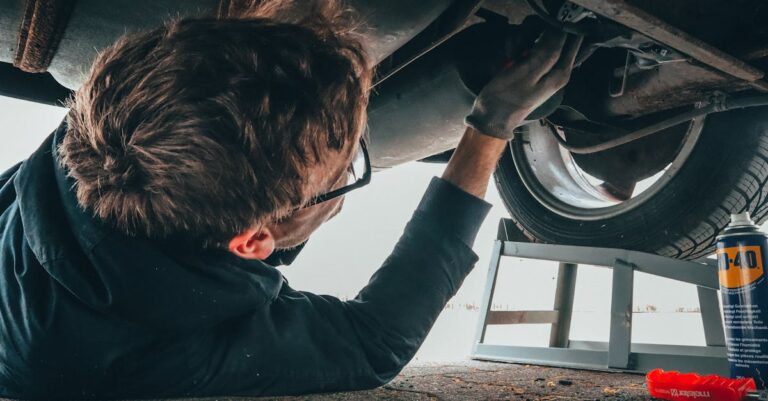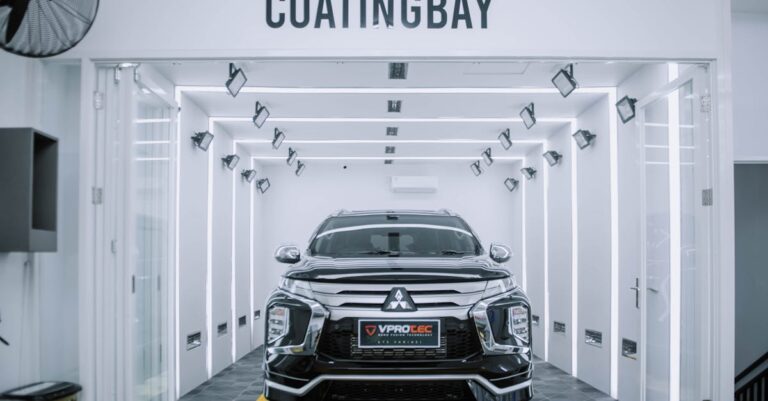Table of Contents
Car Detailing Myths Debunked: Separating Fact from Fiction
Introduction: Why Does Car Detailing Have So Many Myths?
Myth #1: Dish Soap is Fine for Washing Your Car
The Harsh Reality of Dish Soap
Why Dedicated Car Wash Soap Matters
Myth #2: Washing Your Car Frequently Damages the Paint
The Real Culprit: Improper Washing Techniques
The Benefits of Regular, Correct Washing
Myth #3: Automatic Car Washes are Just as Good as Hand Washing
The Hidden Dangers of Tunnel Washes
The Gentle Touch of Hand Washing
Myth #4: Waxing is Only for Shine, Not Protection
Beyond the Gloss: The Protective Power of Wax
Sealants vs. Waxes: Understanding the Difference
Myth #5: You Only Need to Detail Your Car When Selling It
Myth #6: Leather Seats Don’t Need Conditioning
Keeping Leather Luxurious: The Need for Conditioning
Myth #7: Clay Bars Will Strip Your Paint
Understanding Clay Bar Decontamination
Myth #8: Tire Shine Damages Tires
Choosing the Right Shine: Water vs. Solvent Based
Myth #9: Expensive Products Always Mean Better Results
Myth #10: Detailing is Just a Fancy Car Wash
Detailing vs. Washing: A World of Difference
Conclusion: Embrace the Truth for a Pristine Ride
Frequently Asked Questions (FAQs)
1. How often should I really get my car detailed?
2. Can I detail my car myself, or should I hire a professional?
3. Is ceramic coating better than traditional wax?
4. What’s the biggest mistake people make when washing their car at home?
5. Does detailing increase my car’s resale value?
The Article
Car Detailing Myths Debunked: Separating Fact from Fiction
Let’s talk cars. Specifically, let’s talk about keeping them looking their absolute best. Car detailing seems like it should be straightforward, right? Wash, wax, vacuum… done. But somewhere along the line, a whole bunch of myths and old wives’ tales have sprung up around the process. You’ve probably heard some – maybe even believed a few! It’s like a game of telephone where the original message gets twisted until it’s barely recognizable. Today, we’re grabbing our metaphorical microfiber towels and busting these common car detailing myths wide open, separating the car care facts from the fiction that could actually be harming your ride.
Introduction: Why Does Car Detailing Have So Many Myths?
So, why does car detailing seem to attract so much misinformation? Well, part of it comes down to history. Techniques and products have evolved massively over the years. What might have been common practice (or even necessary) decades ago is often outdated or even detrimental with modern vehicle finishes and detailing technology. Think about paint technology alone – it’s vastly different now!
Another factor? Marketing. Companies want to sell products, and sometimes that involves simplifying things or even creating a perceived need where one doesn’t necessarily exist. Plus, everyone seems to have an opinion. Your neighbor, your uncle, that guy you met at the gas station – they all have their “tried and true” methods, often passed down without much critical thought. It’s easy for hearsay to become accepted wisdom, even if it’s completely wrong. Let’s cut through the noise and get to the truth.
Myth #1: Dish Soap is Fine for Washing Your Car
Oh, this one is a classic! You’re out of car wash soap, the car is filthy, and that bottle of dish soap under the sink looks mighty tempting. It cuts grease on your pans, so it must be great for road grime, right? Wrong. So, so wrong.
The Harsh Reality of Dish Soap
Think about what dish soap is designed to do: strip away every last bit of grease and food residue from your plates and cutlery. It’s a powerful degreaser. Now, imagine applying that same stripping power to your car’s paintwork. Your car’s paint isn’t baked on lasagna; it has protective layers, like wax or sealant, designed to shield the clear coat and underlying paint from the elements (UV rays, bird droppings, acid rain, etc.). Dish soap doesn’t discriminate. It will aggressively strip away any wax or sealant protection you have, leaving your paint vulnerable and exposed. It can also dry out rubber seals and plastic trim, leading to premature aging and cracking. It’s essentially like using harsh laundry detergent to wash your face – it gets it “clean,” but at the cost of stripping away essential oils and causing irritation.
Why Dedicated Car Wash Soap Matters
Proper car wash soap is specifically formulated to be pH neutral or very close to it. This means it’s gentle on your paint and, crucially, it won’t strip away those vital protective layers (wax, sealants, or coatings). Good car wash soaps contain lubricants that help lift dirt and grit away from the surface and allow your wash mitt to glide smoothly, minimizing the risk of scratching. They’re designed to clean effectively without causing harm. Using the right tool for the job makes all the difference, and in this case, dish soap is absolutely the wrong tool.
Myth #2: Washing Your Car Frequently Damages the Paint
Have you ever heard someone say they avoid washing their car too often because they’re afraid it will wear down the paint or cause scratches? This myth likely stems from bad experiences, but the frequency of washing isn’t the real issue.
The Real Culprit: Improper Washing Techniques
It’s not how often you wash, but how you wash that matters. If you’re using that old, gritty sponge you found in the garage, a single bucket filled with dirty water, or drying with a rough bath towel, then yes, you are absolutely damaging your paint every time you wash! These poor techniques grind dirt and grit into the clear coat, causing swirl marks (those spiderweb like scratches visible in direct sunlight) and other imperfections. Using automatic car washes with harsh brushes (more on that next) also contributes to this myth.
The Benefits of Regular, Correct Washing
Washing your car regularly (think weekly or bi weekly, depending on conditions) using proper techniques is actually beneficial. It removes harmful contaminants like bird droppings, bug guts, tree sap, and road salt before they have a chance to etch into or bond with your paintwork. Think of it like brushing your teeth; doing it regularly prevents cavities. Regular, safe washing prevents paint damage. Use the two bucket method (one for soapy water, one for rinsing the mitt), employ grit guards in the buckets, use a quality microfiber or lambswool wash mitt, and dry with plush microfiber drying towels. Done correctly, frequent washing keeps your car looking great and protects the paint.
Myth #3: Automatic Car Washes are Just as Good as Hand Washing
The allure of the automatic car wash is strong. Drive in dirty, drive out clean(ish) in five minutes? Sounds great! But convenience often comes at a cost, and in this case, the cost is potentially borne by your car’s finish.
The Hidden Dangers of Tunnel Washes
Many automatic car washes, especially the tunnel types with spinning brushes, are notorious for causing swirl marks and scratches. Those giant brushes? They whip around, slapping against your car, often carrying grit and dirt collected from the dozens of cars that went before yours. It’s like being exfoliated with sandpaper! Even “touchless” washes can be problematic. They often rely on extremely harsh chemicals (strong acids or alkalines) to break down dirt without physical contact. These chemicals can strip waxes and sealants, dull plastic trim, and potentially damage sensitive finishes if not rinsed thoroughly. Furthermore, the high pressure water jets, while good for removing loose debris, can force water into panel gaps or potentially aggravate existing stone chips.
The Gentle Touch of Hand Washing
A proper hand wash, using the safe techniques mentioned earlier (two buckets, grit guards, quality mitt, etc.), is significantly gentler on your paint. You control the process. You ensure the wash mitt is clean before each pass over the paint. You use pH neutral soap. You carefully dry the vehicle. While it takes more time and effort, hand washing drastically reduces the risk of inflicting swirls and scratches. It allows you to pay attention to detail, ensuring all areas are cleaned properly and safely. For preserving your car’s finish, hand washing (or a professional detailer using hand wash methods) is undeniably superior.
Myth #4: Waxing is Only for Shine, Not Protection
Many people think car wax is just about achieving that deep, glossy, wet look. While a good wax certainly enhances shine, its primary role is far more functional: protection.
Beyond the Gloss: The Protective Power of Wax
Think of wax as a sacrificial layer. It sits on top of your clear coat, creating a barrier between your paint and the harsh environment. This barrier helps shield the paint from damaging UV rays (which cause oxidation and fading), acid rain, bird droppings, water spots, and other contaminants. When these contaminants land on the wax layer, they attack the wax first, rather than your precious clear coat. Wax also creates a hydrophobic surface, meaning water beads up and rolls off easily, taking some dirt with it and making future washes easier. Yes, the shine is a fantastic bonus, but the protection is the real reason waxing is a crucial part of car care.
Sealants vs. Waxes: Understanding the Difference
It’s worth noting the difference between traditional carnauba waxes and modern paint sealants (and even further, ceramic coatings). Carnauba waxes, derived from palm trees, offer a warm, deep glow but typically last weeks to a few months. Paint sealants are synthetic polymers designed for durability, often lasting several months up to a year. They bond chemically to the paint and offer excellent protection, though some argue the shine isn’t quite as deep as carnauba. Ceramic coatings are the next level, offering years of protection. Regardless of your choice (wax, sealant, or coating), the principle remains: adding a protective layer is vital, and it does much more than just make your car shiny.
Myth #5: You Only Need to Detail Your Car When Selling It
This is a common mindset: “Why bother keeping it perfect now? I’ll just get it detailed before I sell it to maximize the price.” While a pre sale detail is definitely a good idea, neglecting regular detailing throughout your ownership is shortsighted.
Consistent detailing isn’t just about aesthetics; it’s about preservation. Regularly cleaning and protecting the paint, interior surfaces, wheels, and trim prevents long term damage and degradation. Letting dirt bake onto the paint, allowing spills to set into upholstery, or neglecting leather can lead to permanent staining, etching, cracking, and fading. By the time you decide to sell, some of this damage may be irreversible or very costly to fix, potentially lowering the resale value more than the cost of regular maintenance detailing would have been. Furthermore, don’t you want to enjoy driving a clean, well maintained car yourself? Regular detailing enhances your ownership experience, keeping your car looking and feeling fresh day in and day out, not just on the day you hand over the keys.
Myth #6: Leather Seats Don’t Need Conditioning
Modern leather seats often come with protective coatings from the factory, leading some to believe they don’t require the same level of care as older leather interiors. While they might be more resilient initially, skipping conditioning altogether is a mistake.
Keeping Leather Luxurious: The Need for Conditioning
Think of leather like your own skin. Over time, exposure to UV rays, heat fluctuations, and simple friction from getting in and out of the car can cause the leather (and its protective coating) to dry out. Dry leather becomes brittle, loses its supple feel, and is more prone to cracking and fading. While you might not need to slather it in heavy, oily conditioners like in the old days, modern leather still benefits immensely from regular cleaning and conditioning. A quality leather cleaner removes dirt and oils transferred from skin and clothes, while a dedicated leather conditioner replenishes moisture, restores suppleness, and provides UV protection to prevent drying and cracking. It keeps your leather looking, feeling, and smelling luxurious for years to come.
Myth #7: Clay Bars Will Strip Your Paint
The idea of rubbing a bar of clay over your car’s paint can sound intimidating. Some people worry that it’s too aggressive and will actually remove paint or clear coat. This is a misunderstanding of what a clay bar does.
Understanding Clay Bar Decontamination
A detailing clay bar isn’t designed to remove paint; it’s designed to remove contaminants bonded to the surface of the paint that regular washing won’t lift. Think of things like industrial fallout, rail dust (tiny metal particles), paint overspray, and stubborn tree sap. These contaminants make the paint feel rough to the touch, even after washing, and they can interfere with wax or sealant bonding. The clay bar, used with a proper lubricant (like a quick detailer spray), glides over the surface and gently shears off these protruding contaminants, pulling them into the clay. It doesn’t abrade the clear coat itself when used correctly. It’s a decontamination step, not an abrasive polishing step. Skipping this crucial step before waxing or polishing means you’re essentially sealing in those contaminants or grinding them around with your polishing pad.
Myth #8: Tire Shine Damages Tires
You love that deep, black, glossy look on your tires, but maybe you’ve heard rumors that tire shine products can actually cause cracking or browning. Is there any truth to this?
Choosing the Right Shine: Water vs. Solvent Based
The key here lies in the type of tire shine product used. Cheaper, older formulas often rely heavily on petroleum based solvents or silicone oils. These solvents can, over time, leach protective compounds (like anti ozonants) out of the rubber, leading to premature drying, browning, and cracking. They often produce an overly greasy, sling prone finish as well. However, modern, high quality tire shines are typically water based. These formulas nourish the rubber and provide UV protection without using harsh solvents. They often provide a more natural satin or semi gloss finish that doesn’t attract as much dust and is less likely to sling onto your paintwork. So, the myth isn’t entirely baseless, but it applies mostly to older, solvent heavy products. Choose a quality, water based tire dressing, apply it correctly (to a clean tire, often using an applicator pad rather than spraying directly), and you’ll enhance the look without harming the rubber.
Myth #9: Expensive Products Always Mean Better Results
Walk down the car care aisle, and you’ll see a vast range of products with equally vast price tags. It’s easy to assume that the bottle costing three times as much must perform three times better, right? Not necessarily.
While there’s often a correlation between price and quality (better ingredients, more research and development, higher concentrations), cost isn’t the only factor. Sometimes you’re paying for fancy packaging, extensive marketing campaigns, or simply brand name recognition. There are many excellent, reasonably priced car care products available from reputable brands that perform exceptionally well. Conversely, some expensive “boutique” products might offer diminishing returns for the average user. The most crucial factors are often proper technique, understanding what a product is designed to do, and choosing the *right* product for the specific task, rather than just the most expensive one. Don’t be afraid to research reviews and try different products within your budget; you might be surprised at the results you can achieve without breaking the bank.
Myth #10: Detailing is Just a Fancy Car Wash
Perhaps the biggest myth of all is that “detailing” is just a glorified term for washing your car really thoroughly. This couldn’t be further from the truth.
Detailing vs. Washing: A World of Difference
A car wash, whether by hand or machine, is primarily focused on removing surface dirt and grime. It’s about basic cleaning. Car detailing, on the other hand, is a comprehensive process aimed at restoring, enhancing, and protecting *all* aspects of a vehicle, inside and out, to bring it to the best possible condition. Detailing goes far beyond a simple wash. It typically includes:
- A meticulous hand wash and decontamination (clay bar).
- Paint correction (polishing) to remove swirl marks, scratches, and other imperfections.
- Application of protective layers like wax, sealant, or ceramic coating.
- Cleaning and dressing wheels, tires, and wheel wells.
- Cleaning glass inside and out.
- Deep cleaning the interior: vacuuming carpets and upholstery, cleaning and conditioning leather/vinyl/plastic surfaces, cleaning door jambs, vents, and crevices.
- Engine bay cleaning (optional but common).
Detailing is about precision, rejuvenation, and protection. It’s an art and a science that requires knowledge, skill, specialized tools, and quality products. It transforms a car from merely clean to truly pristine.
Conclusion: Embrace the Truth for a Pristine Ride
So there you have it – ten common car detailing myths thoroughly debunked. From the dangers of dish soap to the true purpose of waxing, understanding the facts is the first step towards properly caring for your vehicle. Don’t let outdated advice or clever marketing fool you into practices that could harm your car’s finish or interior. By embracing correct techniques and using the right products for the job, you can move beyond the myths and keep your car looking stunning, protected, and enjoyable for years to come. Happy detailing!
Frequently Asked Questions (FAQs)
1. How often should I really get my car detailed?
This depends on your car’s usage, storage conditions, and your personal standards. A full detail (including paint correction if needed) might be done once or twice a year. However, maintenance detailing (thorough wash, interior clean up, topping up protection) is beneficial every 1 to 3 months. Regular washing (using safe methods!) should ideally be done weekly or bi weekly.
2. Can I detail my car myself, or should I hire a professional?
You can absolutely detail your car yourself! It requires learning the right techniques, investing in some quality products and tools (like microfiber towels, wash mitts, buckets with grit guards), and dedicating the time. However, tasks like paint correction (machine polishing) require more skill and equipment. If you lack the time, skills, or desire, hiring a reputable professional detailer ensures top notch results safely.
3. Is ceramic coating better than traditional wax?
Ceramic coatings offer significantly longer lasting protection (years vs. months for waxes/sealants), superior chemical resistance, and enhanced hydrophobic properties. They create a harder, more durable layer. However, they are more expensive and require meticulous surface preparation before application. Waxes and sealants are easier to apply, more affordable, and can still provide excellent protection and shine, just requiring more frequent reapplication.
4. What’s the biggest mistake people make when washing their car at home?
Probably the most common and damaging mistake is using only one bucket and/or using a dirty sponge or mitt. This essentially grinds dirt back into the paintwork, causing swirl marks and scratches. Using the two bucket method with grit guards and a clean, quality wash mitt is crucial for a safe wash.
5. Does detailing increase my car’s resale value?
Absolutely! A well maintained, professionally detailed car presents significantly better to potential buyers than a dirty, neglected one. It shows pride of ownership and suggests the car has been well cared for mechanically too. While it might not recoup the entire cost of years of detailing, it can certainly help you achieve a faster sale and a higher selling price compared to an equivalent undetailed vehicle.









